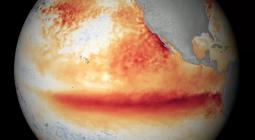Is the UN warning of 3.1C global warming a surprise?
The headlines are pretty grim - without action the world could warm by a massive 3.1C this century, the UN says in a new report published today.
But how likely is that?
As is often the case with climate change and the science behind it - the answer is complicated.
The UN Emissions Gap report indicates that if only “current policies” are implemented the world could warm by up to 3.1C.
This would be “catastrophic” for the world according to the UN, leading to dramatic increases in extreme weather events including heatwaves and floods.
Working outside under that level of warming would be extremely difficult if not impossible.
But that number isn't strictly new, and has to be seen in context.
The UN's predictions of temperature rise have stayed essentially the same over the past three years since countries met in Glasgow for COP26.
The new report says: "A continuation of current policies is estimated to limit global warming to a maximum of 3.1C (range 1.9-3.8C) over the course of the century."
This figure is in line with a projection from the most recent IPCC report from 2021 which showed a rise of up to 3.6C of warming this century under a higher level of emissions.
Today's report says that if countries put into action the promises they have already made in their carbon cutting plans then temperatures will rise by 2.6C to 2.8C.
And if every country puts these plans into action and follows through on their existing net zero pledges, the Emissions Gap report says the rise could be contained to 1.9C.
These cooler scenarios are obviously far from guaranteed and let's be clear - even a rise of 1.9C would be disastrous. We've heated our planet by 1.1C so far and we're feeling the effects on so many levels, not least an increase in extreme weather and rising sea levels.
Promises, and frustration
That these temperature projections haven't really budged is one of the things that is frustrating the UN - while countries have made promises at COP27 and COP28, action on the ground has been very slow.
The UN report says that the goals of the Paris agreement to keep global temperatures under 2C while making efforts to stay below 1.5C are now in very serious danger.
However, it is important to bear in mind the timing of this report, coming just a few weeks before political leaders gather in Azerbaijan for COP29.
Countries have agreed to put new carbon cutting plans on the table by next spring. These will cover the ten years to 2035.
Scientists understand that if the emissions curve isn’t bent by then, extremely challenging temperature rises around or above 3C will be likely.
This next set of plans, called nationally determined contributions, have been described by the UN climate chief as among the most important documents produced this century.
So this report has to be seen as part of the push for higher ambition from world leaders.
What else is new in the report?
There are a number of factors that are new and helping to push up emissions according to the UN.
A boom in flying in 2023 saw carbon from aviation rise 19.5% compared to 2022, as passenger travel returned close to pre-pandemic levels.
Road transport emissions also rose, but there were other key factors including the impact of climate change, driving up temperatures forcing people to resort to more air conditioning.
“We are seeing or starting to see more severe impacts of climate change, so heat waves have driven up energy demand for cooling of homes and offices,” said Dr Anne Olhoff, from UNEP.
“They have also impacted the hydropower generation, which has gone down. And what do you then do when it goes down? You switch to more coal.”
Another element is the transition to electricity for vehicles and heating – the increasing number of electric vehicles and heat pumps are also driving up demand for power, often met by fossil fuel sources.
Cover photo: Climate change is leading to more of the type of weather conditions that risk wildfires




